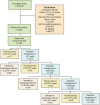Gestational Age of Delivery in Pregnancies Complicated by Diabetes
- PMID: 33408574
- PMCID: PMC7755549
- DOI: 10.31486/toj.20.0019
Gestational Age of Delivery in Pregnancies Complicated by Diabetes
Abstract
Background: The recommended gestational age to deliver pregnancies complicated by diabetes ranges from 34 to 39 weeks of gestation. The objective of this study was to determine the optimal gestational age for delivery of patients with diabetes to minimize perinatal death. Methods: We extracted a population-based cohort of singleton, nonanomalous infants of diabetic pregnancies from the Missouri birth registry for the period January 1, 1989 to December 31, 2005 and compared perinatal outcomes of planned deliveries at 37, 38, 39, and 40 weeks to expectant management. Planned deliveries were identified by induction or cesarean delivery without documented medical or obstetric indications. The primary outcome was perinatal death, defined as stillbirth or neonatal death within 28 days of birth. Secondary outcomes were independent stillbirth, independent neonatal death, and a composite adverse neonatal event of assisted ventilation >30 minutes, birth injury, seizures, or 5-minute Apgar score ≤3. Groups were compared using t test and chi-square as appropriate. Results: In 4,905 diabetic pregnancies reaching 37 weeks, 1,012 (20.6%) patients were insulin dependent. Overall, the risk of perinatal death at any gestational age examined was low (3/1,000 births or lower), as was the risk of the adverse perinatal outcome (<2%). When only patients who were insulin dependent were included in the analysis, the risk of perinatal death at any gestational age remained low at 6 per 1,000 births or fewer. Conclusion: Delivery as early as 37 weeks is reasonable for women who have diabetes, although the absolute risk of perinatal death is low at 37 to 39 weeks.
Keywords: Diabetes mellitus–type 1; diabetes mellitus–type 2; gestational age; infant–small for gestational age; perinatal death; pregnancy in diabetics; stillbirth.
©2020 by the author(s); Creative Commons Attribution License (CC BY).
Figures
Similar articles
-
Term small-for-gestational-age infants from low-risk women are at significantly greater risk of adverse neonatal outcomes.Am J Obstet Gynecol. 2018 May;218(5):525.e1-525.e9. doi: 10.1016/j.ajog.2018.02.008. Epub 2018 Feb 17. Am J Obstet Gynecol. 2018. PMID: 29462628
-
Planned home births: the need for additional contraindications.Am J Obstet Gynecol. 2017 Apr;216(4):401.e1-401.e8. doi: 10.1016/j.ajog.2017.01.012. Epub 2017 Jan 30. Am J Obstet Gynecol. 2017. PMID: 28153656
-
Perinatal mortality and neonatal and maternal outcome per gestational week in term pregnancies: A registry-based study.Acta Obstet Gynecol Scand. 2023 Jan;102(1):82-91. doi: 10.1111/aogs.14467. Epub 2022 Oct 20. Acta Obstet Gynecol Scand. 2023. PMID: 36263854 Free PMC article.
-
Cesarean section on request at 39 weeks: impact on shoulder dystocia, fetal trauma, neonatal encephalopathy, and intrauterine fetal demise.Semin Perinatol. 2006 Oct;30(5):276-87. doi: 10.1053/j.semperi.2006.07.009. Semin Perinatol. 2006. PMID: 17011400 Review.
-
Induction of labour at 41 weeks or expectant management until 42 weeks: A systematic review and an individual participant data meta-analysis of randomised trials.PLoS Med. 2020 Dec 8;17(12):e1003436. doi: 10.1371/journal.pmed.1003436. eCollection 2020 Dec. PLoS Med. 2020. PMID: 33290410 Free PMC article.
Cited by
-
Diabetes during Pregnancy: A Maternal Disease Complicating the Course of Pregnancy with Long-Term Deleterious Effects on the Offspring. A Clinical Review.Int J Mol Sci. 2021 Mar 15;22(6):2965. doi: 10.3390/ijms22062965. Int J Mol Sci. 2021. PMID: 33803995 Free PMC article. Review.
References
-
- Resnik R, Lockwood C, Moore T, Greene M, Copel J, Silver R, eds. Creasy and Resnik's Maternal-Fetal Medicine: Principles and Practice. 8th ed Elsevier; 2018.
Grants and funding
LinkOut - more resources
Full Text Sources

